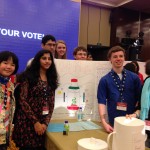Global Competency or Global Understanding? Reflections following an Extraordinary Week in China

Standing on the Great Wall of China
I was ecstatic when I found out recently that I had been selected by EF Tours for a full scholarship to travel to China last month for a Global Student Leadership Summit! This was an opportunity to see student global collaboration and problem solving in action, and to brainstorm and collaborate with other educators from Colorado and around the U.S. to start building a plan for students in my district to address global competency in a comprehensive way. Ever since my first travel experiences outside of the U.S. many, many years ago– to Mexico with my high school choir, and Europe with my college choir –I have understood that my thinking, my understanding, and my world view were different from those of my peers and my family, I believe, as a result of this travel. Sure, I had participated in the obligatory “cultural” experiences of my schooling – making crepes in French class, having an “international fair” with my Girl Scout troop, and even exchanged some letters with a French pen pal. None of that prepared me for actually being in another country, where not only many of the buildings, but the traditions date back hundreds and hundreds, if not thousands of years. This makes Mt. Vernon seem downright new – and brings an unbelievably new perspective to a person’s thinking in a way that is difficult to describe. Not to mention the perspective gained through real relationships formed. In both of these travel experiences of my youth, I was pushed way outside my comfort zone. Brief as they were, we were immersed in the culture, in my case, through the language, the music, the historical sites we visited, the food we ate, the personal stories shared by our excellent guides, and staying with host families at least part of the time. I was excited to see this impact on the students at the Summit.
It is this kind of experience, I believe, that leads to global understanding. People who travel abroad with an open mind can experience this. (Note –open mind required!) It goes beyond “global competency.” Don’t get me wrong – global competency is essential for our students’ future success – and certainly better than nothing, but there is a huge difference between knowing something –and really understanding something.

Winners of the Judge’s Choice Award: Innovation Village at #EFSummit
In China, in addition to the group of educators I traveled with, about 400 American and Chinese high school students were brought together for the Global Student Leadership Summit to use the Stanford dSchool Design Thinking process to design and present solutions to global issues. This was true global collaboration. Students came together to address a topic they were passionate about, and in the case of the Chinese students, in a language that was not their own. They had just two days to accomplish this! (The rest of the week, we spent touring in and experiencing the culture of Shanghai and Beijing.) During the Summit, students were inspired by NPR’s Planet Money hosts, Adam Davidson and Alex Blumberg, and by former ambassador to China, Jon Huntsman Jr. Click on the image below to see some highlights of the Summit experience:

Here is what I am wondering: Can we duplicate the intensity of an immersion experience through technology – to go beyond global competency to achieve this kind of global understanding? I believe whenever possible, we need to make travel experiences like this available to our students, but when travel is not possible, technology can and must help bridge the gap between global competency and true global understanding. Veronica Mansilla and Anthony Jackson state in their book, Educating for Global Competence: Preparing our Youth to Engage the World.Published by the Council of Chief State School Officers and The Asia Society:
Videoconferencing, social networking, and other communication technologies now allow students unprecedented opportunities to investigate issues of global significance with students around the world—much the way working professionals now operate in global teams.
Tools and ideas to transform education. Sign up below.
The issue, though, is how in-depth teachers design these learning experiences to be. A simple cultural exchange about weather, holiday traditions, music, and foods, while students sit surrounded by their own comforts of home, might be a good starting point for young students, but for older students, to really grow their global understanding, we need to design opportunities for actual cross-cultural collaborative problem solving. It is through this kind of experience that we will develop students as future leaders.
I encourage you to investigate EF Tours for future Student Leadership Summits, service learning, exchange programs, and travel opportunities for students and educators – I am quite impressed with the programs they offer. Also check out Flat Connections for opportunities for technology-enabled global, collaborative problem solving. On my Global Collaboration Wiki Resource page, I have listed several other links to help students make connections through service learning and problem solving globally.
cross posted at Innovations in Education
Nancy White is the 21st Century Learning & Innovation Specialist for Academy School District 20, providing professional development on 21st century skills and technology integration, and working with the IT-ES team to carry out the district’s 21st Century Learning Plan. Nancy served on an ad-hoc team to help with the integration of 21st century skills into Colorado’s revised content standards, and co-authored The Colorado Learner's Bill of Rights. Read more at Innovations in Education.
